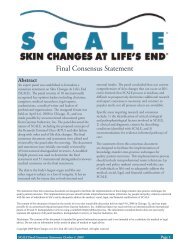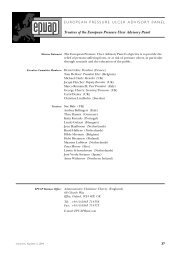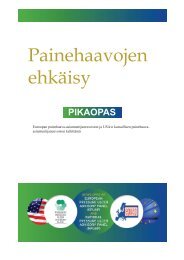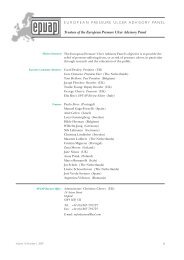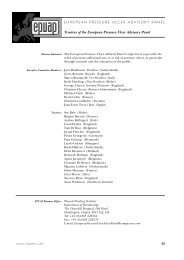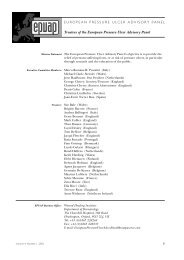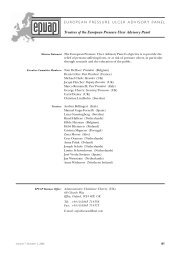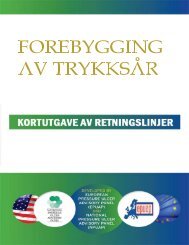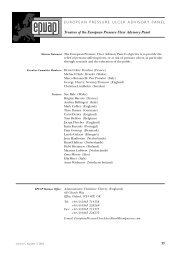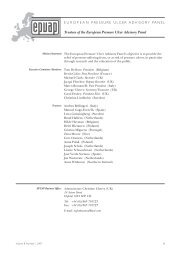EPUAP Review 5/2 RIP - European Pressure Ulcer Advisory Panel
EPUAP Review 5/2 RIP - European Pressure Ulcer Advisory Panel
EPUAP Review 5/2 RIP - European Pressure Ulcer Advisory Panel
You also want an ePaper? Increase the reach of your titles
YUMPU automatically turns print PDFs into web optimized ePapers that Google loves.
EUROPEAN PRESSURE ULCER ADVISORY PANEL<br />
Chernoff R. Improved nutrition aids wound care. Home<br />
Care Case Management 1996; 3(5): 67–8.<br />
Chernoff R. Policy: nutrition standards for treatment of<br />
pressure ulcers. Nutrition <strong>Review</strong>s. 1996; 54(1 Pt 2): S43.<br />
Choussat H, Dartenuc JY, Belooussoff T. [Treatment of<br />
bedsores in a geriatric milieu]. Therapeutique. 1976;<br />
52(9): 485–6.<br />
Clark JJ. Wound repair and factors influencing healing.<br />
Critical Care Nursing Quarterly 2002; 25(1): 1–12.<br />
Closs SJ. Orthopaedics. Malnutrition: the key to pressure<br />
sores? Nursing Standard. 1993; 8(4): 32–6.<br />
Colburn L. <strong>Pressure</strong> ulcer prevention for the hospice<br />
patient. Strategies for care to increase comfort. American<br />
J of Hospice Care. 1987; 4(2): 22–6.<br />
Coleman EA, Martau JM, Lin MK, Kramer AM. <strong>Pressure</strong><br />
ulcer prevalence in long-term nursing home residents<br />
since the implementation of OBRA ’87. Omnibus<br />
Budget Reconciliation Act.[comment]. J of the American<br />
Geriatrics Society. 2002; 50(4): 728–32.<br />
Collins N. Nutrition Q&A. Tube feeding and pressure<br />
ulcers. Advances in Skin & Wound Care. 2001; 14(2):<br />
72–3.<br />
Collins N. The difference between albumin and<br />
prealbumin. Advances in Skin & Wound Care. 2001;<br />
14(5): 235–6.<br />
Collins N. Vitamin C and pressure ulcers. Advances in Skin<br />
& Wound Care. 2002; 15(4): 186, 188.<br />
Compher C, Kim JN, Bader JG. Nutritional requirements<br />
of an aging population with emphasis on subacute care<br />
patients. AACN Clinical Issues 1998; 9(3): 441–50.<br />
Copeland-Fields LD, Hoshiko BR. Clinical validation of<br />
Braden and Bergstrom’s conceptual schema of pressure<br />
sore risk factors.[comment]. Rehabilitation Nursing.<br />
1989; 14(5): 257–60.<br />
Copeland-Fields LD, Hoshiko BR. <strong>Pressure</strong> sore risk<br />
assessment: analysis of risk factors… Gosnell <strong>Pressure</strong><br />
Sore Risk Assessment… part 2<br />
Clinical validation of Braden and Bergstrom’s conceptual<br />
schema of pressure sore risk factors. Decubitus 1989;<br />
2(3): 40–3.<br />
Counsell C, Seymour S, Guin P, Hudson A. Interface skin<br />
pressures on four pressure-relieving devices. J of<br />
Enterostomal Therapy. 1990; 17(4): 150–3.<br />
Cruse JM, Lewis RE, Dilioglou S, Roe DL, Wallace WF,<br />
Chen RS. Patients with existing pressure ulcers admitted<br />
to acute care [corrected] [published erratum<br />
appears in Rehabil Nurs 2001 Jan; 28(1): 36]. Journal of<br />
Wocn 2000; 27(4): 216–26.<br />
Cruse JM, Lewis RE, Dilioglou S, Roe DL, Wallace WF,<br />
Chen RS. <strong>Review</strong> of immune function, healing of<br />
pressure ulcers, and nutritional status in patients with<br />
spinal cord injury. J of Spinal Cord Medicine. 2000; 23(2):<br />
129–35.<br />
Cruse JM, Lewis RE, Roe DL, Dilioglou S, Blaine MC,<br />
Wallace WF, et al. Facilitation of immune function,<br />
healing of pressure ulcers, and nutritional status in<br />
spinal cord injury patients. Experimental & Molecular<br />
Pathology. 2000; 68(1): 38–54.<br />
Cruse JM, Wang H, Lewis RE, Cespedes J, Morrison RS,<br />
3rd, Lineaweaver WC, et al. Cellular and molecular<br />
alterations in spinal cord injury patients with pressure<br />
ulcers: a preliminary report. Experimental & Molecular<br />
Pathology. 2002; 72(2): 124–31.<br />
56<br />
Culley F. Clinical. Nursing aspects of pressure sore prevention<br />
and therapy. Brit. J of Nursing 1998; 7(15): 879–80.<br />
Cullum N, Clark M. Intrinsic factors associated with<br />
pressure sores in elderly people. J of Advanced Nursing<br />
1992; 17(4): 427–31.<br />
Cummings J. Tissue viability. Managing the patient with<br />
fractured femur. Nursing Standard - Special Supplement.<br />
1991(13): 11–3.<br />
Cunha DF, Frota RB, Arruda MS, Cunha SF, Teixeira VP.<br />
<strong>Pressure</strong> sores among malnourished necropsied adults<br />
– preliminary data. Revista do Hospital das Clinicas;<br />
Faculdade de Medicina Da Universidade de Sao Paulo.<br />
2000; 55(3): 79–82.<br />
Dangoisse C, Ledoux M. [Prevention and treatment of<br />
pressure ulcers]. Revue Medicale de Bruxelles. 1991; 12(7):<br />
257–66.<br />
Davalos A, Ricart W, Gonzalez-Huix F, Soler S, Marrugat J,<br />
Molins A, et al. Effect of malnutrition after acute stroke<br />
on clinical outcome. Stroke. 1996; 27(6): 1028–32.<br />
Davies PR, Morrow WE, Rountree WG, Miller DC. Epidemiologic<br />
evaluation of decubital ulcers in farrowing<br />
sows. J of the American Veterinary Medical Association. 1997;<br />
210(8): 1173–8.<br />
Declair V. Critical thresholds for pressure ulcer formation<br />
in a porcine model. Wounds A Compendium of Clinical<br />
Research & Practice 1997; 9(4): 111–21.<br />
Declair V. The usefulness of topical application of essential<br />
fatty acids (EFA) to prevent pressure ulcers. Ostomy<br />
Wound Management. 1997; 43(5): 48–52, 54.<br />
Defloor T. [From accepted myths to proven action –<br />
decubitus prevention in home care].[comment]. Tvz.<br />
1997; 107(23): 715–22.<br />
Demling RH. Involuntary weight loss, protein-energy<br />
malnutrition, and the impairment of cutaneous wound<br />
healing. Wounds A Compendium of Clinical Research &<br />
Practice 2001; 13(4)<br />
Dobson J, Ellis S. Creating an optimum healing environment<br />
for a grade V pressure ulcer. J of Wound Care 2001;<br />
10(10): 415–420.<br />
Doillon CJ, Silver FH, Olson RM, Kamath CY, Berg RA.<br />
Fibroblast and epidermal cell–type I collagen interactions:<br />
cell culture and human studies. Scanning<br />
Microscopy. 1988; 2(2): 985–92.<br />
Dolynchuk K, Keast D, Campbell K, Houghton P, Orsted H,<br />
Sibbald G, et al. Best practices for the prevention and<br />
treatment of pressure ulcers. Ostomy Wound Management.<br />
2000; 46(11): 38–52; quiz 53–4.<br />
Dowding C. <strong>Pressure</strong> sores: the role of nutrition. Community<br />
Outlook. 1984: 70.<br />
Dowsett J. Continuing education. Module 1: nutrition. Part<br />
4: the importance of nutrition in wound healing. World<br />
of Irish Nursing 1996; 4(4): Jul–Aug.<br />
Duncan ST, Levi AD. Multi-tiered treatment of pressure<br />
sores in two cynomologous macaques (Macaca<br />
fascicularis). J of Medical Primatology. 2001; 30(5): 283–9.<br />
Dwyer FM, Keeler D. The federal effort to eliminate fraud<br />
and ensure quality care… proceedings of the National<br />
<strong>Pressure</strong> <strong>Ulcer</strong> <strong>Advisory</strong> <strong>Panel</strong>, Fifth National Conference,<br />
‘Monitoring <strong>Pressure</strong> <strong>Ulcer</strong> Healing: an Alternative<br />
to Reverse Staging’ Protocols for wound management<br />
[corrected] [published erratum appears in Nurs<br />
Manage 1997 Dec; 28(12): 12]. Advances in Wound Care<br />
1997; 10(5): 36–8.<br />
Volume 5, Number 2, 2003



